New Jersey is one of the oldest states in the country and boasts a rich and colorful history. Despite its association today with the Jersey Shore and “gym, tan, laundry,” the state is also well known for its beautiful scenery and agrarian roots. After all, its nickname, the Garden State, reminds us that it was a significant food producer for other New England states. The state is home to many native species of plants and animals, including opossums and river otters. New Jersey also has its fair share of spiders. From wolf spiders to black widows, you can find a wide variety of spiders in New Jersey. Here is a list of 10 spiders that make their homes in the Garden State.
#10: Missing Sector Orb Weaver

The missing sector orb weaver builds a distinctive web with a section missing in the top half.
©iStock.com/Sanjiv Shukla
The missing sector orb weaver, Zygiella x-notata, is also known as the silver-sided sector spider. It is a notoriously solitary member of the orb-weaver family Araneidae. Although predominantly found in Europe, it ranges throughout much of the world, including New Jersey.
Adult females measure from 5 to 11 millimeters long, while males typically measure around 7 millimeters long. Their name comes from the distinctive, silvery sheen on the abdomen. Meanwhile, the cephalothorax appears yellowish-brown, and females feature dark markings on the abdomen.
The missing sector orb weaver makes one of the most recognizable webs of all the spiders in New Jersey. The web often features a missing sector in the top half. A missing sector orb weaver will rebuild its web daily in order to catch prey. While you can often find it near human habitats, it rarely bites humans and poses little threat.
#9: Xysticus Auctificus
Xysticus auctificus is one of several spiders in New Jersey that goes only by its scientific name. If you wanted to translate it into English, it would roughly translate to “the enlarging scraped crab spider.” It belongs to the crab spider family Thomisidae and ranges throughout the United States and Canada.
Adult females grow to a maximum length of 10 millimeters, while males measure only 3 to 5 millimeters long. Compared to the flower crab spiders, they tend to have shorter, thicker legs. They appear predominantly orangish-brown, although the abdomen normally appears creamish-white. Additionally, they feature dark markings on the abdomen and a light V-shaped marking on the cephalothorax.
Like other crab spiders, Xysticus auctificus is an active hunter that does not use webs to catch prey. Instead, it moves slowly along the ground or plants and grabs prey that wanders too close before delivering a venomous bite.
#8: Basilica Orb Weaver

The basilica orb-weaver features a dazzling array of colors on its abdomen.
©iStock.com/johnandersonphoto
Mecynogea lemniscata is more commonly known as the basilica orb weaver. It is one of the most brightly decorated orb-weaving spiders in New Jersey. While mostly found in the eastern United States, its range includes a few central and western states.
Adult basilica orb weavers measure between 5 and 9 millimeters long, with females measuring larger than males. Unlike most orb weavers, the abdomen appears rectangular instead of spherical. The dorsal side of the long abdomen features orange, brown, yellow, and black inlays edged by thin red and white lines. Meanwhile, the carapace appears similar to a cat’s eye with brown edges, an orange iris, and a black line down the center.
Despite belonging to the Araneidae family, basilica orb-weavers build dome-shaped webs to capture prey. Interestingly, they do not rebuild damaged webs; instead, they simply construct new ones when necessary. Their bite is not medically significant.
7: Rabid Wolf Spider

Rabid wolf spiders are harmless to humans, but larger specimens can give a painful bite.
©Brett Hondow/Shutterstock.com
The rabid wolf spider, Rabidosa rabida, belongs to the wolf spider family Lycosidae. You can find this large spider in New Jersey as well as throughout much of the eastern United States. It gets its name from its sporadic movements, which make it appear as if it is rabid.
Adult females measure from 16 to 21 millimeters long, and males measure around 13 millimeters long. At their largest, some females can reach up to 25 millimeters in length. These spiders look predominantly yellow except for two dark brown stripes down the cephalothorax and one dark stripe down the center of the abdomen.
Like other members of their family, rabid wolf spiders are active hunters that do not use webs to catch prey. Despite their large size and imposing name, their bite poses little danger to humans.
#6: Dark Fishing Spider
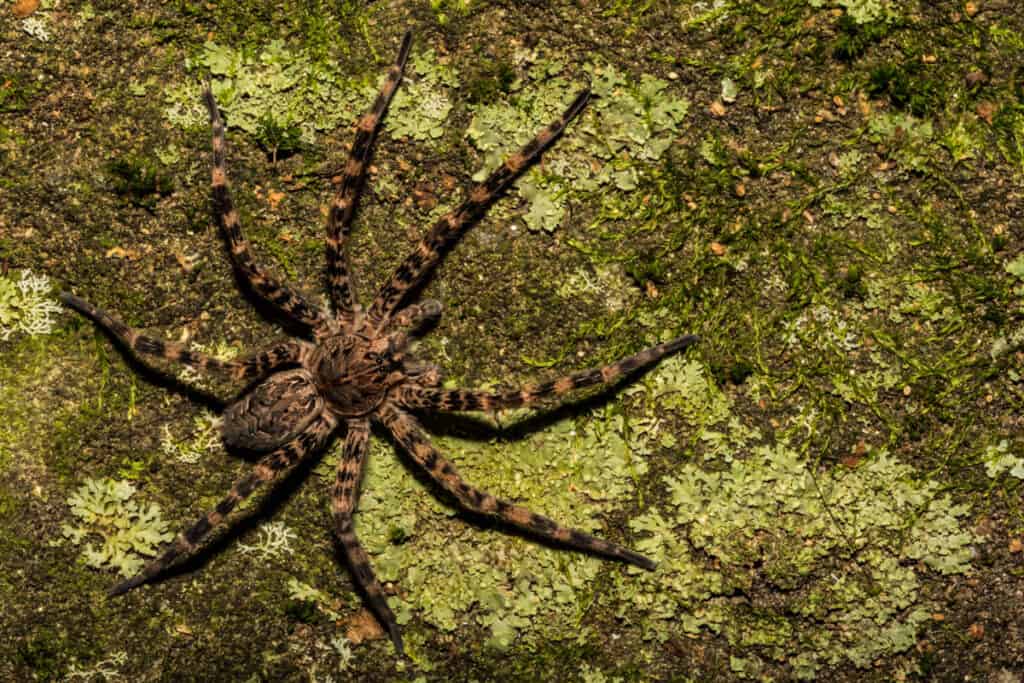
The dark fishing spider can run across the surface of water or dive into the water to catch prey.
©iStock.com/JasonOndreicka
Dolomedes tenebrosus, or the dark fishing spider, belongs to the nursery web spider family Pisauridae. You can find these spiders in New Jersey as well as throughout much of the central and eastern United States and Canada.
Adult females can measure up to 2.5 centimeters long. Meanwhile, males typically only measure about half that size. They appear predominantly light brown, while dark spots and spines cover their legs. You can normally identify them thanks to the characteristic dark W-shaped markings on their abdomen.
Dark fishing spiders do not build webs to catch their prey. Instead, they use their long legs like fishing lures to snag insects and even small fish from the water. They can also run across the surface of water for short distances or dive below the surface to find food. While they can bite humans, they usually run from people, and their bite is not medically significant.
#5: Red-Femured Spotted Orb Weaver

The red-femured spotted orb weaver often builds its web on buildings.
©samray/Shutterstock.com
The red-femured spotted orb weaver, Neoscona domiciliorus, is the third orb-weaver to make our list of spiders in New Jersey. It is endemic to the United States and found mostly in the eastern half of the country. You can often find this spider on buildings, hence the name domiciliorus, which comes from the Latin domiciliorum, or “of dwellings.”
Adult females measure 7 to 16 millimeters long, and males measure around 8 millimeters long. Females sport short, grey hairs on their bodies while males have relatively short, straight abdomens. They feature a characteristic bright yellow or white marking on the back of the abdomen. The first segment of each leg is red, hence their name, while the other segments alternate in color between white and black.
Red-femured spotted orb weavers are nocturnal hunters that use their webs to capture prey. While venomous, their bite is not medically significant.
#4. Green Lynx Spider
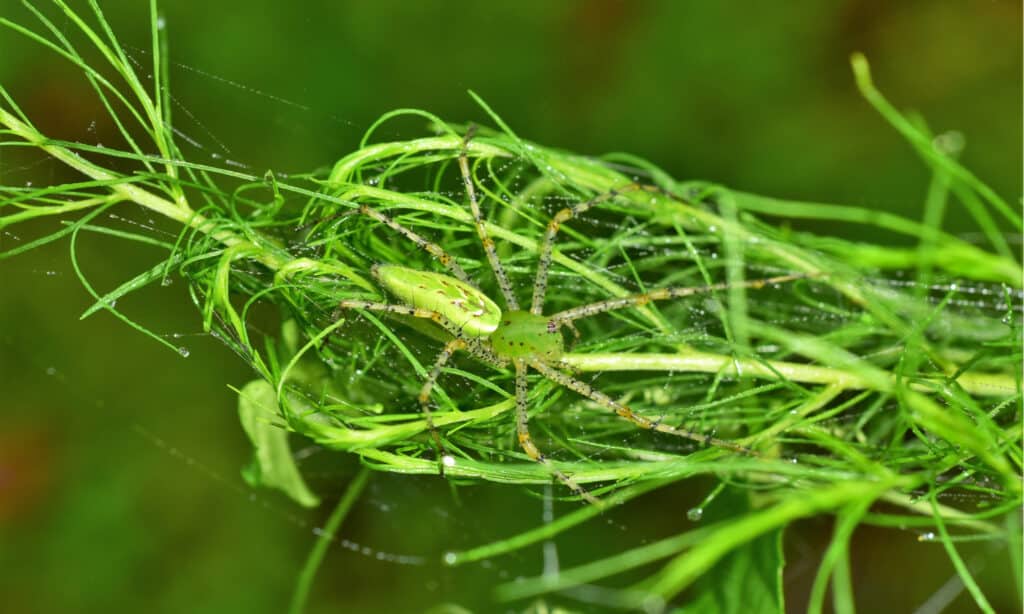
The green lynx spider’s color helps it blend into its environment.
©Ken Beard/Shutterstock.com
Peucetia viridans, or the green lynx spider, is a member of the lynx spider family Osyopidae. Its range extends as far south as Venezuela and also includes the West Indies.
The green lynx spider is one of the largest lynx spiders in New Jersey. An adult female typically measures between 12 and 22 millimeters long, while the average male measures slightly smaller. As its name implies, its body appears predominantly bright green. That said, it features red markings on its sides while the legs look yellowish-green.
Rather than building webs, green lynx spiders actively wander about in search of prey. Their bright green color helps them to blend in with leaves and other vegetation. They often feed on moths and other insects that feed on agricultural crops. For this reason, many farmers see green lynx spiders as a beneficial species. Their bite poses little danger to humans.
#3. Emerald Jumping Spider
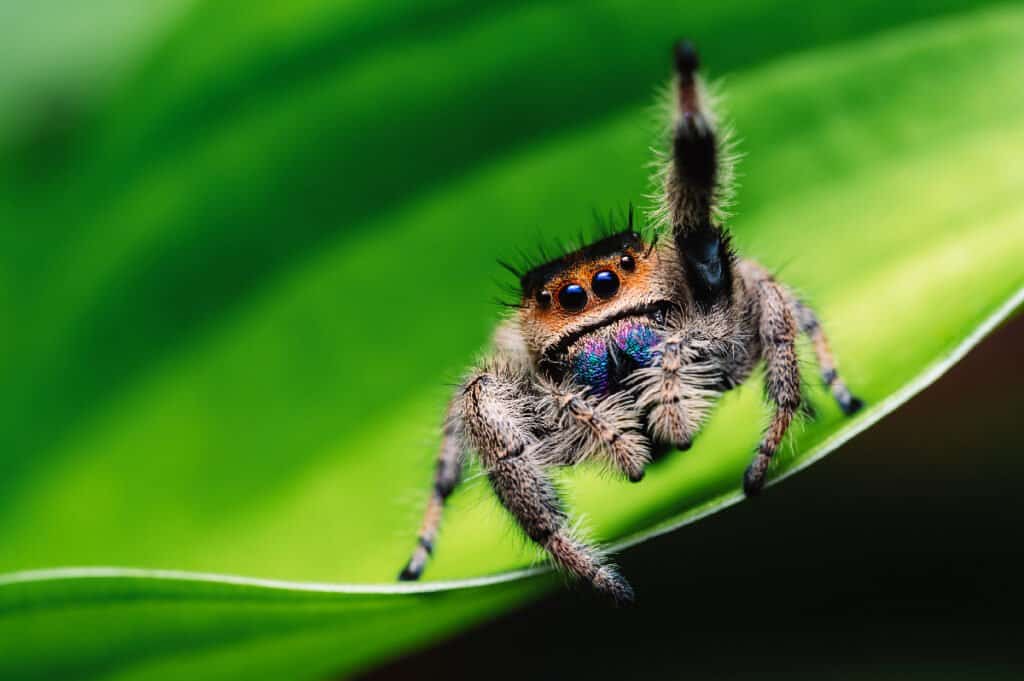
The emerald jumping spider possesses excellent eyesight and amazing leaping abilities.
©iStock.com/Jan Rozehnal
The emerald jumping spider, Paraphidus aurantius, belongs to the jumping spider family Salticidae. You can find these brightly colored spiders in New Jersey and throughout much of the United States and Central America.
Female emerald jumping spiders measure between 8 and 12 millimeters long, while males measure from 7 to 10 millimeters long. Males appear predominantly black, aside from a white stripe on either side of the head. Meanwhile, females look mostly brown with some orange markings. That said, both sexes sport characteristic metallic green mouthparts or chelicerae, hence their name.
Emerald jumping spiders rely on their keen eyesight and powerful jumping ability to help them catch prey. Given their power and size, they can easily kill and eat insects more than twice their size. While fearsome hunters in their own right, they pose little to no threat to humans.
#2: Broad-Faced Sac Spider
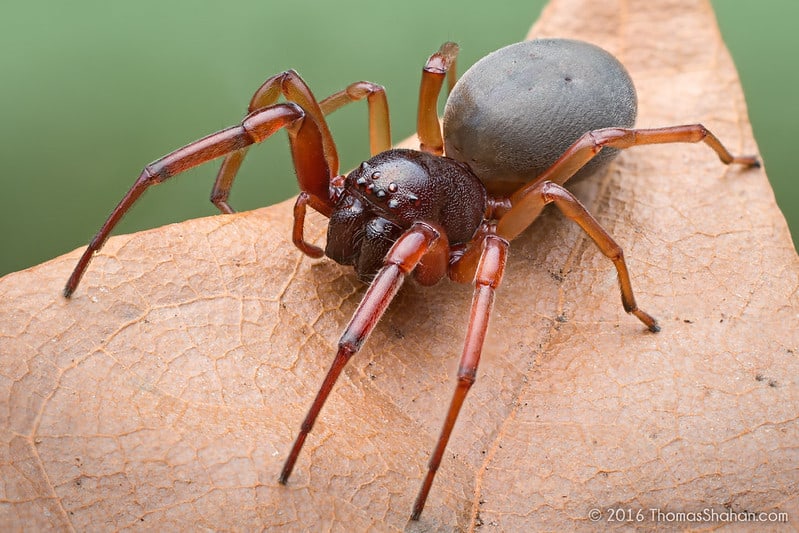
The broad-faced sac spider will willingly scavenge for dead spiders and insects.
©Thomas Shahan / flickr – License
Trachelas tranquillus, or the broad-faced sac spider, belongs to the ground sac spider family Trachelidae. Its range covers most of the central and eastern United States and also parts of Canada.
Female broad-faced sac spiders measure from 7 to 10 millimeters long, and males measure between 5 and 6 millimeters long. The chelicerae and carapace appear reddish-brown, while their abdomen can vary in color from yellow to light grey. Meanwhile, their thin legs appear orangish-red.
During the day, broad-faced sac spiders hide in silken retreats and then emerge at night to hunt for food. Unlike most other spiders in New Jersey, they will willingly scavenge for food and often eat dead insects and other spiders. Their bite can be quite painful and may also cause secondary infections. That said, bites are not medically significant and require little to no medical attention in most situations.
#1. Northern Black Widow
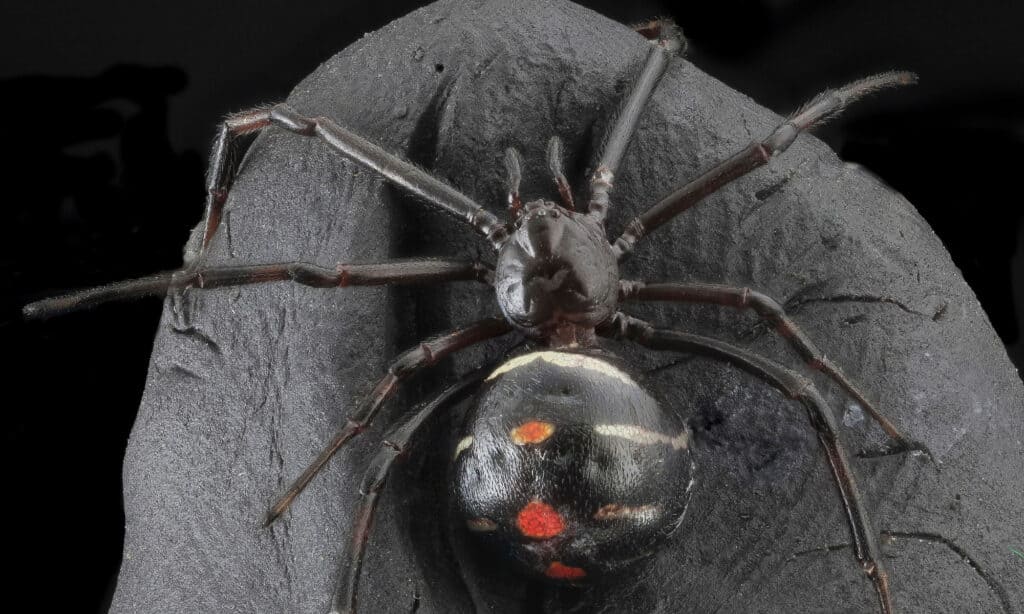
Several people are hospitalized each year due to bites from northern black widow spiders.
©Porco_Rosso/Shutterstock.com
The northern black widow, Latrodectus variolus, belongs to the cobweb spider family Theridiidae. As its name implies, it ranges widely throughout the eastern and northern United States and Canada.
Adult females measure between 9 and 11 millimeters long, while males measure from 4 to 5 millimeters. As is typical with other widows, they appear predominantly black except for a small red hourglass-shaped marking on the abdomen. Unlike its close relatives, the hourglass marking on a northern black widow is not intact, which can help you differentiate it from other widows.
Northern black widows are one of the most venomous spiders in New Jersey, thanks to their potent venom, which is capable of causing latrodectism. Common bite symptoms include pain, vomiting, sweating, and muscle rigidity. While bites rarely prove fatal, it’s a good idea to seek medical attention if you get bitten by a northern black widow.
Summary Of 10 Spiders In New Jersey
| Rank | Spider |
|---|---|
| 1 | Northern Black Widow |
| 2 | Broad-Faced Sac Spider |
| 3 | Emerald Jumping Spider |
| 4 | Green Lynx Spider |
| 5 | Red-Femured Spotted Orb Weaver |
| 6 | Dark Fishing Spider |
| 7 | Rabid Wolf Spider |
| 8 | Basilica Orb Weaver |
| 9 | Xysticus Auctificus |
| 10 | Missing Sector Orb Weaver |
The photo featured at the top of this post is © Porco_Rosso/Shutterstock.com
Thank you for reading! Have some feedback for us? Contact the AZ Animals editorial team.






